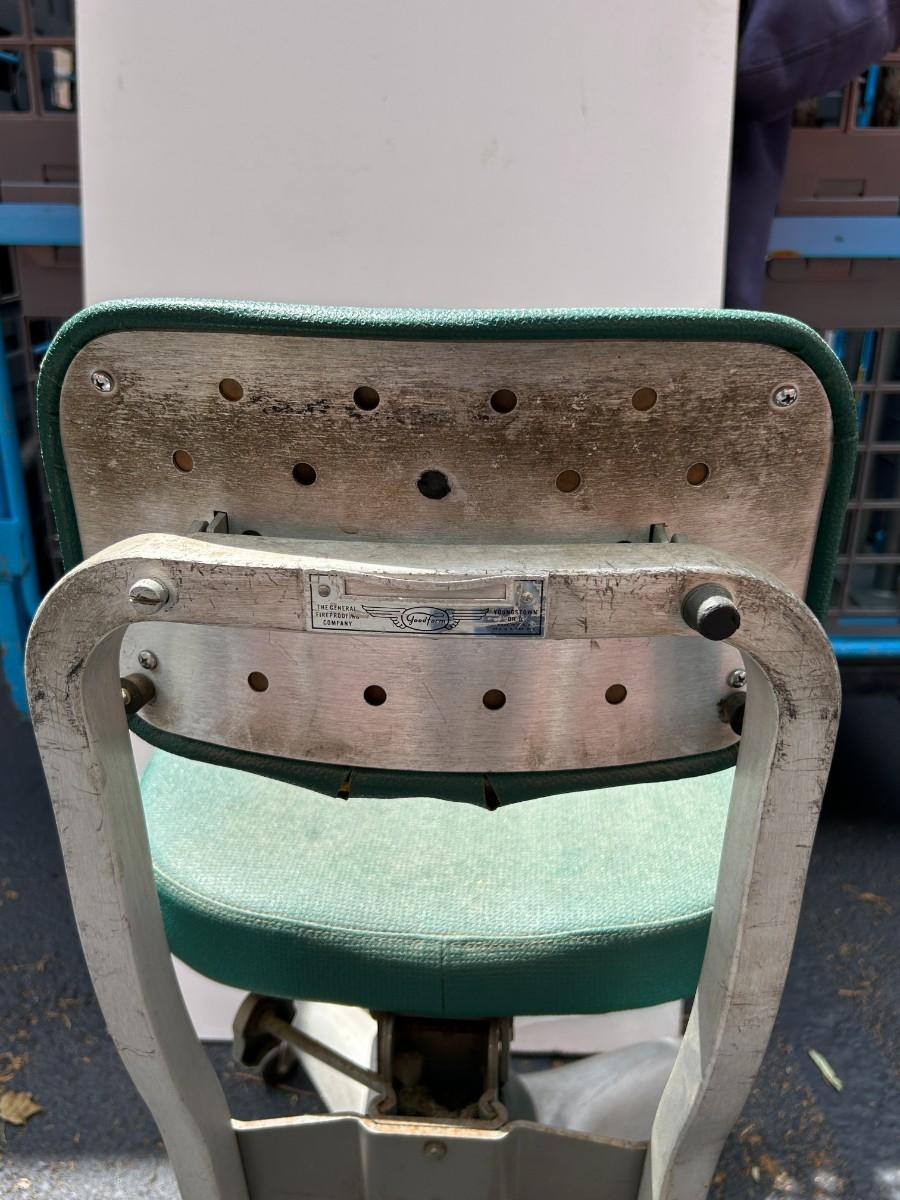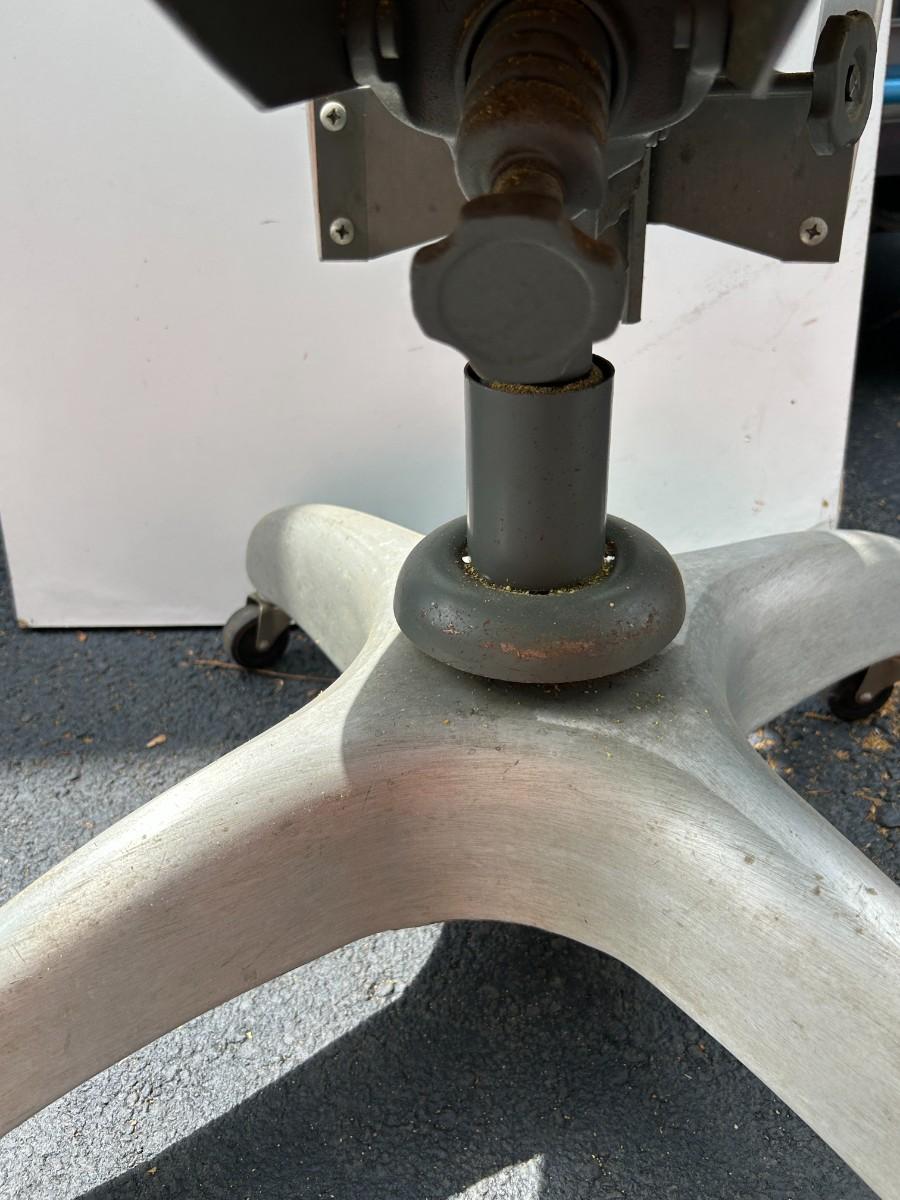Vintage Mid-Century c. 1950s Good Form Industrial Green Adjustable Tanker Chair
Reserve in place and offers welcome via text at 404-431-7249
Vintage Mid-Century c. 1950s Good Form Industrial Green Adjustable Tanker Chair
Machine-age industrial tanker desk chair with 4-star aluminum propeller base. Gio Ponti was originally designed in 1936 for the Montecatini Building, Milano, Italy, as a symbol of modernity. Since then, the model has been updated and was manufactured by Good Form for the U.S. market in the 1950s. Steel tube frame, aluminum 4-prong propeller base, vinyl seat, and back. Signed, made in Youngstown, Ohio by Good Form, for General Fireproofing Company, circa 1976.
Disclosures: This chair had one owner who bought it new. The chair has grime on the undercarriage and bottom of the seat. However, the chair works perfectly, and the vinyl has no tears or rips.
Dimensions: 25” Width x 17” Depth x 30” Adjustable Height
Cushion: 15” Width x 14” Depth
Base: 25” Width (at widest point)
Height to Seat: 19" (Adjustable)
Retail: $2,800; we reduced our price due to the rust.
About the Designer (Giò Ponti:)
An architect, industrial furniture designer, and editor, Giò Ponti was arguably the most influential figure in 20th-century Italian Modernism. Ponti designed thousands of furnishings and products — from cabinets, lamps, and chairs to ceramics and coffeemakers — and his buildings, including the brawny Pirelli Tower (1956) in his native Milan and the castle-like Denver Art Museum (1971), were erected in 14 countries. Through Domus, the magazine he founded in 1928, Ponti brought attention to virtually every significant movement and creator in modern art and design. The questing intelligence Ponti brought to Domus is reflected in his work: as protean as he was prolific, Ponti’s style can’t be pegged to a specific genre. In the 1920s, as artistic director for the Tuscan porcelain maker Richard Ginori, he fused old and new; his ceramic forms were modern but decorated with motifs from Roman antiquity. In pre-war Italy, modernist design was encouraged. After the conflict, Ponti and designers such as Carlo Mollino, Franco Albini, and Marco Zanuso found a receptive audience for their novel, idiosyncratic work. Ponti’s typical furniture forms from the period, such as the wedge-shaped Distex chair, are simple, gently angular, colorful, equally elegant, and functional. In the 1960s and ’70s, Ponti’s style evolved again as he explored biomorphic shapes and embraced the expressive, experimental designs of Ettore Sottsass Jr., Joe Colombo, and others. His signature furniture piece — the one by which he is represented in the collections of the Museum of Modern Art in New York, Germany’s Vitra Design Museum, and elsewhere — is the sleek Superleggera chair, produced by Cassina starting in 1957. (The name translates as “superlightweight” — advertisements featured a model lifting it with one finger.) Ponti had a playful side, best shown in a collaboration he began in the late 1940s with the graphic artist Piero Fornasetti. Ponti furnishings were decorated with bright finishes and Fornasetti's whimsical lithographic transfer prints of things such as butterflies, birds or flowers; the Montreal Museum of Fine Arts possesses a 1950 secretary from their Architetturra series, which feature case pieces covered in images of building interiors and facades. The grandest project Ponti and Fornasetti undertook, however, lies on the floor of the Atlantic Ocean: the interiors of the luxury liner Andrea Doria, which sank in 1956. Widely praised retrospectives at the Queens Museum of Art in 2001 and at the Design Museum London in 2002 sparked a renewed interest in Ponti among modern design aficionados. (Marco Romanelli’s monograph written for the London show offers a fine overview of Ponti’s work.) Today, a wide array of Ponti’s designs are snapped up by savvy collectors who want to give their homes a touch of Italian panache and effortless chic.











